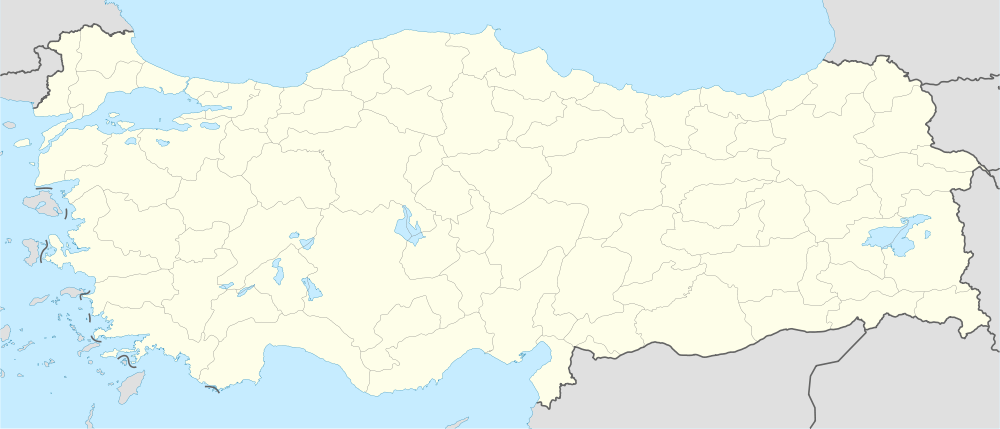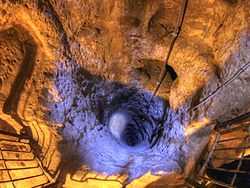Derinkuyu
| Derinkuyu | |
|---|---|
| District | |
|
Deep ventilation well in Derinkuyu Underground City | |
 Location of Derinkuyu within Turkey. | |
 Derinkuyu Location of Derinkuyu within Turkey. | |
| Coordinates: 38°22′N 34°44′E / 38.367°N 34.733°E | |
| Country |
|
| Region | Central Anatolia |
| Province | Nevşehir |
| Government | |
| • Governor | Murat Duru |
| • Mayor | Ahmet Balcı (MHP) |
| Area[1] | |
| • District | 444.89 km2 (171.77 sq mi) |
| Elevation | 1,300 m (4,300 ft) |
| Population (2012)[2] | |
| • Urban | 10,804 |
| • District | 21,945 |
| • District density | 49/km2 (130/sq mi) |
| Time zone | EET (UTC+2) |
| • Summer (DST) | EEST (UTC+3) |
| Postal code | 50xxx |
| Area code(s) | 0384 |
| Licence plate | 50 |
| Website | www.derinkuyu.gov.tr |
Derinkuyu ("deep well") is a town and district of Nevşehir Province in the Central Anatolia region of Turkey. According to 2010 census, population of the district is 22,114 of which 10,679 live in the town of Derinkuyu.[3][4] The district covers an area of 445 km2 (172 sq mi),[5] and the average elevation is 1,300 m (4,265 ft), with the highest point being Mt. Ertaş at 1,988 m (6,522 ft).
Located in Cappadocia, Derinkuyu is notable for its large multi-level underground city (Derinkuyu Underground City), which is a major tourist attraction. The historical region of Cappadocia, where Derinkuyu is situated, contains several historical underground cities, carved out of a unique geological formation. They are not generally occupied. Over 200 underground cities at least two levels deep have been discovered in the area between Kayseri and Nevşehir, with around 40 of those having at least three levels. The troglodyte cities at Derinkuyu and Kaymaklı are two of the best examples of underground dwellings.
History
The oldest written source about underground cities is the writings of Xenophon. In his Anabasis he writes that the people living in Anatolia had excavated their houses underground, living well in accommodations large enough for the family, domestic animals, and supplies of stored food.[6]
Derinkuyu Underground City provided a refuge for the region's Proto-Anatolian inhabitants through the ages. From Byzantine times through 1923 it was known by its Cappadocian Greek inhabitants as Malakopea (Greek: Μαλακοπέα),[7] and likewise served as a refuge from the raids of the Umayyad Arab and Abbasid armies. The cities contained food stores, kitchens, stalls, churches, wine and oil presses, ventilation shafts, wells, and a religious school. The Derinkuyu underground city has at least eight levels and depth of 85 m and could have sheltered thousands of people. David Wilcock noted that, the city’s origins may be even earlier and related to the ancient Persian Zoroastrian tradition. In the ancient Zoroastrian Vendidad legends exist of how Ahura-Mazda instructed Yima to build an underground refuge very similar to that seen in Derinkuyu.[8]
See also
- Avanos
- Churches of Göreme, Turkey
- Eskigümüş Monastery
- Ihlara Valley
- Mokissos
- Özkonak Underground City
- Zelve Monastery
Notes
- ↑ "Area of regions (including lakes), km²". Regional Statistics Database. Turkish Statistical Institute. 2002. Retrieved 2013-03-05.
- ↑ "Population of province/district centers and towns/villages by districts - 2012". Address Based Population Registration System (ABPRS) Database. Turkish Statistical Institute. Retrieved 2013-02-27.
- ↑ Statistical Institute
- ↑ GeoHive. "Statistical information on Turkey's administrative units". Retrieved 2008-04-14.
- ↑ Statoids. "Statistical information on districts of Turkey". Retrieved 2008-04-14.
- ↑ Xen. An. 4.5.24-7.
- ↑ Peter Mackridge, "Some Pamphlets on Dead Greek Dialects': R.M. Dawkins and Modern Greek Dialectology", 1990. p. 205. "Anyone who attempts to find the Greek villages of Cappadocia today, either on the map or on the ground, is first faced by the problem that their names have been obliterated, a chauvinistic practice not only prevalent in modern Turkey, but practiced in Greece as well. Visitors to the so-called 'underground cities' at Kaymakli and Derinkuyu have difficulty in ascertaining that until 1923 they were called Anaku and Malakopi respectively (the latter being the Μαλακοπαία of Theophanes. Once located, however, these villages bear obvious traces of their Greek Christian past in the shape of sizable churches (some of which have been converted into mosques and are therefore well preserved, but with their frescoes covered with whitewash), and a number of rather elegant houses, whose Greekness is betrayed only by the initials and dates (usually about ten years before the 1923 exchange of populations."
- ↑ Kaveh farrokh- Iranica
References
- Falling Rain Genomics, Inc. "Geographical information on Derinkuyu, Turkey". Retrieved 2008-04-14.
- Governorship of Derinkuyu, Turkey. "General information on Derinkuyu, Nevşehir" (in Turkish). Retrieved 2008-04-14.
External links
| Wikimedia Commons has media related to Derinkuyu. |
- District governor's official website (Turkish)
- District municipality's official website (Turkish)
Coordinates: 38°22′25″N 34°44′05″E / 38.37361°N 34.73472°E
